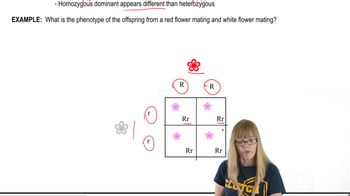Table of contents
- 1. Introduction to Genetics51m
- 2. Mendel's Laws of Inheritance3h 37m
- 3. Extensions to Mendelian Inheritance2h 41m
- 4. Genetic Mapping and Linkage2h 28m
- 5. Genetics of Bacteria and Viruses1h 21m
- 6. Chromosomal Variation1h 48m
- 7. DNA and Chromosome Structure56m
- 8. DNA Replication1h 10m
- 9. Mitosis and Meiosis1h 34m
- 10. Transcription1h 0m
- 11. Translation58m
- 12. Gene Regulation in Prokaryotes1h 19m
- 13. Gene Regulation in Eukaryotes44m
- 14. Genetic Control of Development44m
- 15. Genomes and Genomics1h 50m
- 16. Transposable Elements47m
- 17. Mutation, Repair, and Recombination1h 6m
- 18. Molecular Genetic Tools19m
- 19. Cancer Genetics29m
- 20. Quantitative Genetics1h 26m
- 21. Population Genetics50m
- 22. Evolutionary Genetics29m
21. Population Genetics
Hardy Weinberg
Problem 28
Textbook Question
Textbook QuestionA total of 1000 members of a Central American population are typed for the ABO blood group. In the sample, 421 have blood type A, 168 have blood type B, 336 have blood type O, and 75 have blood type AB. Use this information to determine the frequency of ABO blood group alleles in the sample.
 Verified Solution
Verified SolutionThis video solution was recommended by our tutors as helpful for the problem above
Video duration:
2mPlay a video:
Was this helpful?
Key Concepts
Here are the essential concepts you must grasp in order to answer the question correctly.
ABO Blood Group System
The ABO blood group system is determined by the presence of antigens on the surface of red blood cells, specifically A and B antigens. There are four main blood types: A, B, AB, and O, which correspond to different combinations of these antigens. Blood type A has A antigens, type B has B antigens, type AB has both, and type O has neither. Understanding this system is crucial for analyzing allele frequencies in a population.
Recommended video:
Guided course

Variations on Dominance
Allele Frequency
Allele frequency refers to how often a particular allele appears in a population compared to other alleles for the same gene. It is calculated by dividing the number of copies of the allele by the total number of alleles in the population. In the context of the ABO blood group, allele frequencies can be determined by counting the occurrences of each blood type and translating these into the corresponding alleles (A, B, and O).
Recommended video:
Guided course

New Alleles and Migration
Hardy-Weinberg Equilibrium
The Hardy-Weinberg equilibrium is a principle that describes the genetic variation in a population that is not evolving. It provides a mathematical model to predict allele and genotype frequencies under certain conditions, such as no mutation, migration, or selection. This concept is essential for understanding how allele frequencies can be expected to behave in a stable population, allowing for comparisons with observed frequencies to identify evolutionary changes.
Recommended video:
Guided course

Hardy Weinberg

 13:4m
13:4mWatch next
Master Hardy Weinberg with a bite sized video explanation from Kylia Goodner
Start learningRelated Videos
Related Practice

